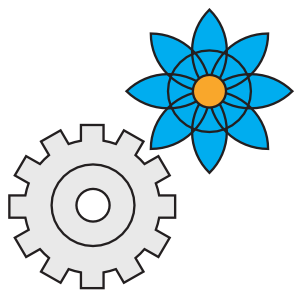Digital-Starter-Kit-Release-Jan-2021
Main Learning Outcomes
- to not only solve problems, but to actually define them
- to learn with and from others
- share, analyze and discuss information on technology and society
- to practice participation and democratic interaction
- to consider technology and nature as social conditions
Student Driven Course Design
- professor/lecturer is responsible for the seminar and supervises the student tutors
- student tutors
- organize the entire seminar
- conduct one third of the seminar
- students
- are involved and interact all of the time
- conduct two thirds of the seminar
- contribute to the future development of the seminar
Hard Facts of the Seminar
- concept is used now for 10 years and is continually developed
- transferable and adaptable concept - established at nine universites
- integrated as compulsory elective module in numerous Bachelor study programs
- 3 to 6 ECTS points
- analogue seminar - 90 > 180 minutes presence time
- digital seminar - 90 > 120 minutes presence time plus 60 minute preparation/follow-up
- in total around 400 students per semester
- 150 participants per semester at TU Berlin with three tutors
- 30 participants per semester at TU Hamburg with two tutors
- fully established at nine universities in Germany plus two to come in the next summer semester
- TU Berlin, TU Hamburg, TU Dresden, Uni Stuttgart, TH Köln, HAW Hamburg, HTW Berlin, HS Düsseldorf, HS Ruhr West
- Uni Rostock, Uni Paderborn
one time per week - 2 hours phase 1: tutors moderate some basic building blocks (weeks 1 - 5), phase 2: participants present (weeks 6 - 8) phase 3: participants present improved version (weeks 10 - 12)
Building blocks - What is that? modular teaching/learning units covering one topic preparation - video conference - follow-up diverse methods and didactics - well documented teaching/learning process is largely transferred towards participants good moderation instead of experts’ knowledge
Example Building Block - 100 points
Examination - 100 points in total
50 points – semester project: develop, perform and document a building block with your team 50 points – personal journal: reflect the weekly sessions Participation in weekly video conference is mandatory max. 2 missed sessions per semester
Semester Project: develop, perform and document an own building block - 50 out of 100 points
The semester project counts for 50 out of 100 points of the entire course Work steps semester project Participants develop a new teaching unit (building block) Documentation of the building block Dress rehearsal of the building block Peer-to-peer feedback Incorporation of feedback Premiere of the building block Submission of documentation - final version No frontal presentation
How to design your building block
30 min - digital teaching/learning unit on a self-chosen topic preparation - video conference - follow-up diverse methods and didactics - well documented teaching/learning process is largely transferred towards participants good moderation instead of experts’ knowledge have a look at examples of good digital building blocks (e.g. 100 points, plastics)
Personal Learning Journal – What is it for? - 50 out of 100 points record your reflection on seminar’s content and your personal conclusions use the tools within your journal go a step further: newspaper articles, documentaries, conversations with friends… include creative elements: inner dialogue, sketches, collages, role plays, songs… some tasks of preparation and follow-up can be done in the journal about 300 words per entry analogue or digital (submission as PDF)

